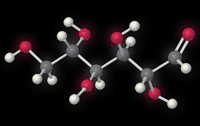Carbohydrates are organic, water-soluble substances. They are comprised of the elements carbon, hydrogen, and oxygen in the formula (CH20)n, with 'n' ranging from 3 to 7. Dietary carbohydrates are obtained almost solely from plant-derived sources (lactose being an exception).
Carbohydrates are classified into one of three groups depending on their chemical structure:
- Monosaccharides
- Oligosaccharides
- Polysaccharides
 Types of Carbohydrates
Types of Carbohydrates 

 Monosaccharides
Monosaccharides
-
Monosaccharides are the "basic units" of carbohydrates. The number of carbon atoms in their ring distinguishes these basic units from one another. The suffix "ose" is used to identify these molecules as sugars:
- Glucose, also known as blood sugar, is the sugar all other carbohydrates are converted to in the body. Glucose can be obtained through digestion or created by gluconeogenesis.
- Galactose does not exist freely in nature, but rather is found combined with glucose in milk sugar (lactose).
- Fructose, also known as fruit sugar, is the sweetest of the simple sugars. As its name implies, large amounts of fructose are found in fruits. While some fructose does enter directly into the blood from the digestive tract, it is eventually metabolized into glucose in the liver.
| Triose | Monosaccharide with 3 Carbons |
| Tetrose | Monosaccharide with 4 Carbons |
| Pentose | Monosaccharide with 5 Carbons |
| Hexose | Monosaccharide with 6 Carbons |
| Heptose | Monosaccharide with 7 Carbons |
The hextose group includes glucose, galactose, and fructose.
 Oligosaccharides
Oligosaccharides
-
Oligosaccharides are created when 2 to 10 monosaccharides are bonded together. The disaccharides, or double sugars, are formed when 2 monosaccharides are bonded together.
- Lactose (Glucose + Galactose) - The only sugar not found in plants. It is found in milk.
- Maltose (Glucose + Glucose) - Found in beer, cereals, and germinating seeds.
- Sucrose (Glucose + Fructose) - Known as table sugar, is the most commonly digested dietary disaccharide. It is naturally produced in beet sugar, cane sugar, honey, and maple syrup.
Monosaccharides and disaccharides make up the group known as simple sugars.
 Polysaccharides
Polysaccharides
-
Polysaccharides are formed when 3 to 1000's of monosaccharides are bonded together.
- Starch - Plant storage form of carbohydrates. Starch exists in two forms: amylose or amylopectin. Amylose is a long straight chain of glucose molecules helically twisted while amylopectin is a highly branched group of bonded monosaccharides.
- Fiber - A nonstarch, structural polysaccharide found in plants, which is for the most part resistant to digestion. Examples of fiber include cellulose and pectin.
- Glycogen - 100-30,000 glucose molecules linked together. Storage form of glucose.
Types of polysaccharides:
 Ingestion & Digestion
Ingestion & Digestion 
The majority of dietary carbohydrates are consumed in the form of starch. Digestion of starch begins in the mouth by salivary amylase. This digestion by amylase continues in the upper part of stomach, but stops once the amylase is destroyed by gastric acid.
Digestion is then completed in the small intestine by pancreatic amylase. The disaccharide maltose and short-branched chains of glucose are produced from the breakdown of starch by amylase.
Now in the form of maltose and short-branched chains of glucose, these molecules will be broken down into separate glucose molecules by enzymes in the small intestine epithelial cells. The same thing happens when lactose or sucrose is ingested. In lactose, the bond between glucose and galactose is broken, producing two separate monosaccharides.
With sucrose, the bond between glucose and fructose is broken, producing two separate monosaccharides. The separate monosaccharides are then transported across the intestinal epithelium into the blood. When monosaccharides are ingested (such as dextrose, which is glucose), no digestion is needed and they are absorbed quickly.
Once in the blood, these carbohydrates, now in the form of monosaccharides, can be put to use. Since fructose and galactose are eventually converted to glucose, from here out I will simply refer to all digested carbohydrates as glucose.
 Absorbed Glucose
Absorbed Glucose 
Glucose is the body's primary energy source in the absorptive state (during or right after a meal). This glucose is catabolized by cells to acquire energy for ATP formation.
 |
||||
 |
|
 |
||
 |
||||
Glucose can also be stored in the form of glycogen in muscle and liver cells. But before this can happen, the glucose must enter the cells. In addition, glucose enters a cell differently depending on the type of cell.
Before glucose can be metabolized, it must be transported into a cell. This is done by the use of glucose transporters (Glut-1, 2, 3, 4, and 5). In cells where glucose is the primary energy source, such as the brain, kidney, liver, and red blood cells, glucose uptake is unregulated. This means glucose can enter these cells at any time. Adipose (fat) cells, the heart, and skeletal muscle on the other hand have regulated glucose uptake by the Glut-4 transporter.
The hormone insulin regulates the Glut-4 transporters. Insulin is released from the pancreatic beta cells in response to elevated blood glucose levels.
Insulin binds to an insulin receptor on the cell's membrane, which, through other mechanisms, causes the Glut-4 receptors to translocate from intracellular storage sites to the cell membrane, allowing glucose to bind and enter the cell. Contraction of skeletal muscle also increases Glut-4 transporter translocation.
When a muscle contracts, calcium is released. This increase in calcium concentrations stimulates the translocation of the Glut-4 receptors, allowing glucose uptake in the absence of insulin.
While the effects of insulin and exercise on Glut-4 translocation are additive, they are independent. Once inside the cell, the glucose can be used to meet energy demands or be synthesized into glycogen and stored for later use. Glucose can also be transformed into fat and stored in adipose cells.
When in the liver, glucose can be used to meet the liver's energy needs, stored as glycogen or converted to triglycerides to be stored as fat. Glucose is a precursor to -glycerol phosphate and fatty acids. The liver transforms excess glucose instead -glycerol phosphate and fatty acids, which are then combined to synthesize triglycerides.
Some of these newly formed triglycerides are stored in the liver, but most are packaged with proteins into lipoproteins and secreted into the blood.
Lipoproteins that contain way more fat than protein are called very low-density lipoproteins (VLDL). These VLDL are then transported through the blood to be stored in adipose tissue as triglycerides (fat).
 Stored Glucose
Stored Glucose 
 |
||||
 |
|
 |
||
 |
||||
The storage of glucose as glycogen is called glycogenesis. During glycogenesis, one molecule of glucose at a time is added to an existing glycogen molecule.
The amount of stored glycogen in the body is determined by the dietary intake of carbohydrates; a person on a low carbohydrate diet will have less glycogen than a person on a high carbohydrate diet.
In order to use stored glycogen, it must be broken down in separate glucose molecules through the process called glycogenolysis (lysis = breakdown).
 The Importance Of Glucose
The Importance Of Glucose 
The nervous system and brain need glucose to function properly because the brain uses it as an exclusive fuel source. The brain can also use ketones (by-products of incomplete fat breakdown) as an energy source when glucose supply is inadequate, but this is not preferred.
Skeletal muscle and all other cells also use glucose for their energy requirements. When glucose needs are not meet through dietary consumption, glycogen is used. Once glycogen storages are depleted, the body must find a way to get more glucose which is accomplished by gluconeogenesis.
Gluconeogenesis is the formation of new glucose from amino acids, glycerol, lactate, or pyruvate (all non-glucose sources). Muscle protein can be catabolized in order to supply amino acids for gluconeogenesis. By supplying adequate dietary carbohydrates, dietary glucose serves as a "protein sparer," and can save muscle protein from being broken down. Therefore is it important for athletes to eat a sufficient amount of dietary carbohydrates.
| While there is no set RDA for carbohydrates, it is recommended that 40-50% of calories consumed be in the form of carbohydrates. The suggested intake of carbohydrates for athletes is 60% of their caloric intake. Like all things, there is much debate about the amount of carbohydrates one needs. One's carbohydrate intake should be decided after taking many other factors into consideration: |
|
The type of training including the intensity, duration, and frequency, overall caloric intake, performance goals, and body composition goals.
 Summary & Conclusion
Summary & Conclusion 
- Carbohydrates = (CH20)n, with n ranging from 3 to 7
- Monosaccharides are the "basic units" of carbohydrates
- Oligosaccharides are created when 2 to 10 monosaccharides are bonded together.
- Disaccharides, or double sugars, are formed when 2 monosaccharides are bonded together and include sucrose, lactose, and galactose.
- Polysaccharides are formed when 3 to 1000's of monosaccharides are bonded together and include starches, fiber, and glycogen.
- Starch ? Maltose + Short-branched chains of glucose ? Glucose
- Before glucose can be metabolized, it must be transported into a cell. This is done by the use of glucose transporters.
- The hormone insulin regulates the Glut-4 transporters.
- Glucose can be used to create ATP, stored as glycogen, or stored as fat.
- The RDA for carbohydrates is 40-60% of one's calories.
 |
What Does ATP Mean? Adenosine triphosphate, a high energy phosphate molecule used to store and release energy for work within the body. |
 |
 |
||
References
- Houston, Michael (2001). Biochemistry Primer for Exercise Science (2nd Ed.). Illinois: Human Kinetics
- Katch, Frank. Katch, Victor, McArdle, William (2001). Exercise Physiology: Energy, Nutrition, and Human Performance (5th Ed.). Maryland: Lippincott William and Wilkins.
- Widmaier, Eric. Raff, Hershal, Kevin, Strange (2004). Human Physiology: The Mechanisms of Body Function (9th Ed.) Boston: Mcgraw Hill.


